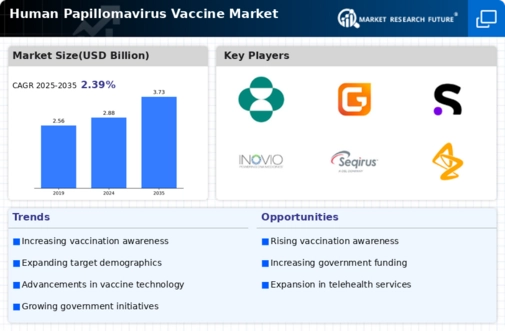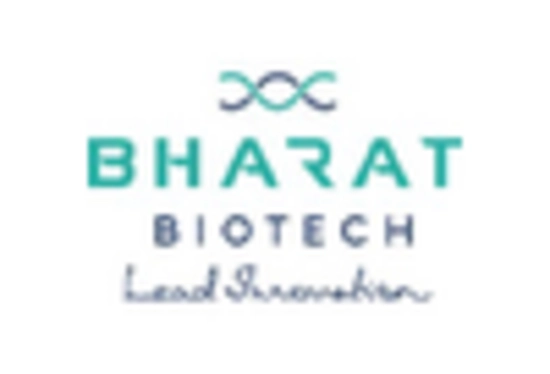Rising Public Health Campaigns
Rising public health campaigns aimed at promoting HPV vaccination are a significant driver for the Human Papillomavirus Vaccine Market. Health organizations and non-profits are increasingly investing in educational initiatives to raise awareness about the benefits of vaccination. These campaigns often target parents, adolescents, and healthcare providers, emphasizing the importance of early vaccination to prevent HPV-related diseases. The success of these campaigns can be seen in the increasing vaccination rates in various regions, which correlates with heightened public awareness. As more individuals become informed about the risks associated with HPV and the protective benefits of vaccination, the demand for HPV vaccines is likely to grow, further propelling market expansion.
Government Initiatives and Policies
Government initiatives and policies play a pivotal role in shaping the Human Papillomavirus Vaccine Market. Many countries have implemented national vaccination programs aimed at increasing HPV vaccination rates among adolescents. These initiatives often include funding for vaccine procurement and public awareness campaigns. For instance, some governments have introduced school-based vaccination programs, which have proven effective in reaching target populations. The financial support from governments not only enhances accessibility but also encourages healthcare providers to promote vaccination. As more countries recognize the importance of HPV vaccination in reducing cancer incidence, the market is expected to experience growth driven by these supportive policies and initiatives.
Increasing Incidence of HPV-Related Cancers
The rising incidence of human papillomavirus (HPV)-related cancers, particularly cervical cancer, is a critical driver for the Human Papillomavirus Vaccine Market. According to recent data, cervical cancer remains one of the leading causes of cancer-related deaths among women. This alarming trend has prompted health authorities to advocate for vaccination as a preventive measure. The World Health Organization has set ambitious targets to eliminate cervical cancer as a public health problem, which includes increasing vaccination coverage. As awareness of the link between HPV and cancer grows, more individuals are likely to seek vaccination, thereby expanding the market. The urgency to address this public health issue is likely to stimulate demand for HPV vaccines, reinforcing their role in cancer prevention.
Global Health Partnerships and Collaborations
The Human Papillomavirus Vaccine Industry. Organizations such as the GAVI Alliance and the Global Fund are working to improve access to HPV vaccines in low- and middle-income countries. These partnerships often focus on funding, technical support, and capacity building to ensure that vaccines reach underserved populations. By facilitating access to HPV vaccination, these collaborations are likely to enhance overall vaccination coverage and reduce the burden of HPV-related diseases. As more countries engage in these partnerships, the market for HPV vaccines is expected to expand, driven by increased availability and accessibility.
Technological Advancements in Vaccine Delivery
Technological advancements in vaccine delivery systems are significantly influencing the Human Papillomavirus Vaccine Market. Innovations such as needle-free delivery methods and improved formulations are enhancing the efficacy and acceptance of HPV vaccines. These advancements may lead to increased vaccination rates, as they address common barriers such as pain and anxiety associated with traditional injections. Furthermore, the development of combination vaccines that protect against multiple strains of HPV could simplify vaccination schedules and improve compliance. As these technologies become more prevalent, they are likely to attract attention from healthcare providers and patients alike, thereby expanding the market for HPV vaccines.


















Leave a Comment